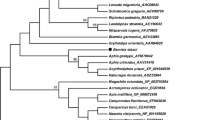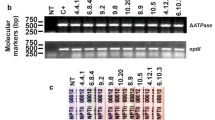Abstract
Intracellular symbiosis impacts many aspects of insect biology, and disruption of these symbioses is a novel insect-pest-control strategy. Horizontally transferred genes (HTGs) are critical for insect-intracellular symbiont association, representing candidate molecular targets for symbiosis disruption. However, few studies have tested this in the laboratory and under field conditions. Biotin and lysine HTGs are involved in Bemisia tabaci MEAM1 symbiosis persistence. In this study, we showed that whitefly biotin and lysine genes can be silenced by the tobacco rattle virus (TRV), a tobravirus. Then, we demonstrated that the vector 2mDNA1, an engineered begomovirus transmitted by B. tabaci, was effective for silencing B. tabaci MED HTGs in the laboratory. The 2mDNA1-silencing biotin HTGs reduced levels of biotin, as well as survival, fecundity, and population increases of whiteflies. The 2mDNA1-silencing biotin HTGs did not impact the titers of symbionts in F0 whiteflies but decreased the titers of symbiont Portiera in F2 whiteflies. The 2mDNA1-silencing lysine HTG reduced levels of lysine, titers of Portiera in both F0 and F2 whiteflies as well as the survival, fecundity, and population increases of whiteflies. The 2mDNA1-mediated silencing of whitefly genes is horizontally transmitted among whiteflies, enhancing the effectiveness of gene silencing. We further revealed that the vector 2mDNA1 can be used to silence whitefly HTGs and inhibit whitefly performance in the greenhouse. This study demonstrates that repressing the expression of insect HTGs though a modified virus is feasible for the control of phloem-feeding insect pests.






Similar content being viewed by others
References
Arora AK, Douglas AE (2017) Hype or opportunity? Using microbial symbionts in novel strategies for insect pest control. J Insect Physiol 103:10–17. https://doi.org/10.1016/j.jinsphys.2017.09.011
Bao XY, Yan JY, Yao YL et al (2021) Lysine provisioning by horizontally acquired genes promotes mutual dependence between whitefly and two intracellular symbionts. Plos Pathog 17:e1010120. https://doi.org/10.1371/journal.ppat.1010120
Baum JA, Bogaert T, Clinton W et al (2007) Control of coleopteran insect pests through RNA interference. Nat Biotechnol 25:1322–1326. https://doi.org/10.1038/nbt1359
Baumann P (2005) Biology of bacteriocyte-associated endosymbionts of plant sap-sucking insects. Annu Rev Microbiol 59:155–189. https://doi.org/10.1146/annurev.micro.59.030804.121041
Briddon RW, Bull SE, Amin I et al (2004) Diversity of DNA 1: a satellite-like molecule associated with monopartite begomovirus-DNA beta complexes. Virology 324:462–474. https://doi.org/10.1016/j.virol.2004.03.041
Brown JK, Frohlich DE, Rosell RC (1995) The sweetpotato or silverleaf whiteflies: biotypes of Bemisia tabaci or a species complex? Annu Rev Entomolo 40:511–534. https://doi.org/10.1146/annurev.en.40.010195.002455
Bublitz DC, Chadwick GL, Magyar JS et al (2019) Peptidoglycan production by an insect-bacterial mosaic. Cell 179:703–712. https://doi.org/10.1016/j.cell.2019.08.054
Carrington LB, Tran BCN, Le NTH et al (2018) Field-and clinically derived estimates of Wolbachia-mediated blocking of dengue virus transmission potential in Aedes aegypti mosquitoes. PNAS 115:361–366. https://doi.org/10.1073/pnas.1715788115
Cathrin PB, Ghanim M (2014) Recent advances on interactions between the whitefly Bemisia tabaci and begomoviruses, with emphasis on Tomato yellow leaf curl virus. Plant Virus-Host Interact. https://doi.org/10.1016/B978-0-12-411584-2.00004-4
Chen W, Hasegawa DK, Kaur N et al (2016) The draft genome of whitefly Bemisia tabaci MEAM1, a global crop pest, provides novel insights into virus transmission, host adaptation, and insecticide resistance. BMC Biol 14:1–15. https://doi.org/10.1186/s12915-016-0321-y
Chung SH, Jing X, Luo Y et al (2018) Targeting symbiosis-related insect genes by RNAi in the pea aphid-Buchnera symbiosis. Insect Biochem Mol Biol 95:55–63. https://doi.org/10.1016/j.ibmb.2018.02.004
De Barro PJ, Liu SS, Boykin LM et al (2011) Bemisia tabaci: a statement of species status. Annu Rev Entomol 56:1–19. https://doi.org/10.1146/annurev-ento-112408-085504
Douglas AE (2015) Multiorganismal insects: diversity and function of resident microorganisms. Annu Rev Entomol 60:17–34. https://doi.org/10.1146/annurev-ento-010814-020822
Douglas AE (2017) The B vitamin nutrition of insects: the contributions of diet, microbiome and horizontally acquired genes. Curr Opin Insect Sci 23:65–69. https://doi.org/10.1016/j.cois.2017.07.012
Eakteiman G, Moses-Koch R, Moshitzky P et al (2018) Targeting detoxification genes by phloem-mediated RNAi: a new approach for controlling phloem-feeding insect pests. Insect Biochem and Molecular Biol 100:10–21. https://doi.org/10.1016/j.ibmb.2018.05.008
Firdaus S, Vosman B, Hidayati N et al (2013) The Bemisia tabaci species complex: additions from different parts of the world. Insect Sci 20:723–733. https://doi.org/10.1111/1744-7917.12001
Gerling D, Alomar Ò, Arnò J (2001) Biological control of Bemisia tabaci using predators and parasitoids. Crop Prot 20:779–799. https://doi.org/10.1016/S0261-2194(01)00111-9
Gong JT, Li Y, Li TP, Hong XY, Baton L (2020) Stable introduction of plant-virus-inhibiting Wolbachia into planthoppers for rice protection. Curr Biol 30:4837–4845. https://doi.org/10.1016/j.cub.2020.09.033
Gottlieb Y, Ghanim M, Gueguen G et al (2008) Inherited intracellular ecosystem: symbiotic bacteria share bacteriocytes in whiteflies. FASEB J 22:2591–2599. https://doi.org/10.1096/fj.07-101162
Gu L, Knipple DC (2013) Recent advances in RNA interference research in insects: Implications for future insect pest management strategies. Crop Prot 45:36–40. https://doi.org/10.1016/j.cropro.2012.10.004
Hajeri S, Killiny N, El-Mohtar C et al (2014) Citrus tristeza virus-based RNAi in citrus plants induces gene silencing in Diaphorina citri, a phloem-sap sucking insect vector of citrus greening disease (Huanglongbing). J Biotechnol 176:42–49. https://doi.org/10.1016/j.jbiotec.2014.02.010
Hogenhout SA, Ammar ED, Whitfield AE et al (2008) Insect vector interactions with persistently transmitted viruses. Annu Rev Phytopathol 46:327–359. https://doi.org/10.1146/annurev.phyto.022508.092135
Huang CJ, Xie Y, Zhou XP (2009) Efficient virus-induced gene silencing in plants using a modified geminivirus DNA1 component. Plant Biotechnol J 7:254–265. https://doi.org/10.1111/j.1467-7652.2008.00395.x
Husnik F, McCutcheon JP (2018) Functional horizontal gene transfer from bacteria to eukaryotes. Nat Rev Microbiol 16:67–79. https://doi.org/10.1038/nrmicro.2017.137
Husnik F, Nikoh N, Koga R et al (2013) Horizontal gene transfer from diverse bacteria to an insect genome enables a tripartite nested mealybug symbiosis. Cell 153:1567–1578. https://doi.org/10.1016/j.cell.2013.05.040
Huvenne H, Smagghe G (2010) Mechanisms of dsRNA uptake in insects and potential of RNAi for pest control: a review. J Insect Physiol 56:227–235. https://doi.org/10.1016/j.jinsphys.2009.10.004
Jiu M, Zhou XP, Liu SS (2006) Acquisition and transmission of Tobacco curly shoot virus by the B biotype of the whitefly, Bemisia tabaci. Acta Phytophy Sin 33:168–172. https://doi.org/10.1360/yc-006-1280
Kanakala S, Kontsedalov S, Lebedev G et al (2019) Plant-mediated silencing of the whitefly Bemisia tabaci cyclophilin B and heat shock protein 70 impairs insect development and virus transmission. Front Physiol 10:557. https://doi.org/10.3389/fphys.2019.00557
Kumar P, Pandit SS, Baldwin IT (2012) Tobacco rattle virus vector: a rapid and transient means of silencing Manduca sexta genes by plant mediated RNA interference. PLoS ONE 7:e31347. https://doi.org/10.1371/journal.pone.0031347
Leonard SP, Powell JE, Perutka J et al (2020) Engineered symbionts activate honey bee immunity and limit pathogens. Science 367:573–576. https://doi.org/10.1126/science.aax9039
Li ZH, Zhou XP, Zhang X et al (2004) Molecular characterization of tomato-infecting begomoviruses in Yunnan, China. Arch Virol 149:1721–32. https://doi.org/10.1007/s00705-004-0334-7
Li NN, Jiang S, Lu KY et al (2022) Bacteriocyte development is sexually differentiated in Bemisia tabaci. Cell Rep 38(9):110455. https://doi.org/10.1016/j.celrep.2022.110455
Liu SS, De Barro PJ, Xu J et al (2007) Asymmetric mating interactions drive widespread invasion and displacement in a whitefly. Science 318:1769–1772. https://doi.org/10.1126/science.1149887
Liu SS, Colvin J, De Barro PJ (2012) Species concepts as applied to the whitefly Bemisia tabaci systematics: how many species are there? J Integr Agr 11:176–186. https://doi.org/10.1016/S2095-3119(12)60002-1
Login FH, Balmand S, Vallier A et al (2011) Antimicrobial peptides keep insect endosymbionts under control. Science 334:362–365. https://doi.org/10.1126/science.1209728
Lu P, Bian G, Pan X et al (2012) Wolbachia induces density-dependent inhibition to dengue virus in mosquito cells. PLoS Negl Trop Dis 6:e1754. https://doi.org/10.1371/journal.pntd.0001754
Luan JB, Yao DM, Zhang T et al (2013) Suppression of terpenoid synthesis in plants by a virus promotes its mutualism with vectors. Ecol Lett 16:390–398. https://doi.org/10.1111/ele.12055
Luan JB, Chen W, Hasegawa DK et al (2015) Metabolic coevolution in the bacterial symbiosis of whiteflies and related plant sap-feeding insects. Genome Biol Evol 7:2635–2647. https://doi.org/10.1093/gbe/evv170
Luan JB, Shan HW, Isermann P et al (2016) Cellular and molecular remodelling of a host cell for vertical transmission of bacterial symbionts. Proc R Soc B 283:20160580. https://doi.org/10.1098/rspb.2016.0580
Luan JB, Sun X, Fei Z et al (2018) Maternal inheritance of a single somatic animal cell displayed by the bacteriocyte in the whitefly Bemisia tabaci. Curr Biol 28:459–465. https://doi.org/10.1016/j.cub.2017.12.041
Mansoor S, Briddon RW, Zafar Y et al (2003) Geminivirus disease complexes: an emerging threat. Trends Plant Sci 8:128–134. https://doi.org/10.1016/S1360-1385(03)00007-4
Mao YB, Cai WJ, Wang JW et al (2007) Silencing a cotton bollworm P450 monooxygenase gene by plant-mediated RNAi impairs larval tolerance of gossypol. Nat Biotechnol 25:1307–1313. https://doi.org/10.1038/nbt1352
Mito T, Nakamura T, Bando T et al (2011) The advent of RNA interference in Entomology. Entomol Sci 14:1–8. https://doi.org/10.1111/j.1479-8298.2010.00408.x
Moran NA, Bennett GM (2014) The tiniest tiny genomes. Annu Rev of Microbiol 68:195–215. https://doi.org/10.1146/annurev-micro-091213-112901
Moran NA, McCutcheon JP (2008) Genomics and evolution of heritable bacterial symbionts. Annu Rev Genet 42:165–190. https://doi.org/10.1146/annurev.genet.41.110306.130119
Nakabachi A, Ishida K, Hongoh Y et al (2014) Aphid gene of bacterial origin encodes a protein transported to an obligate endosymbiont. Curr Biol 24:R640–R641. https://doi.org/10.1016/j.cub.2014.06.038
Nawaz-ul-Rehman MS, Fauquet CM (2009) Evolution of geminiviruses and their satellites. FEBS Lett 583:1825–1832. https://doi.org/10.1016/j.febslet.2009.05.045
Perreau J, Moran NA (2021) Genetic innovations in animal-microbe symbioses. Nat Rev Genet. https://doi.org/10.1038/s41576-021-00395-z
Price DR, Gatehouse JA (2008) RNAi-mediated crop protection against insects. Trends Biotechnol 26:393–400. https://doi.org/10.1016/j.tibtech.2008.04.004
Ren FR, Sun X, Wang TY et al (2020a) Biotin provisioning by horizontally transferred genes from bacteria confers animal fitness benefits. ISME J 14:2542–2553. https://doi.org/10.1038/s41396-020-0704-5
Ren FR, Bai B, Hong JS et al (2020b) A microbiological assay for biotin determination in insects. Insect Sci 28:415–418. https://doi.org/10.1111/1744-7917.12827
Ren FR, Sun X, Wang TY et al (2021) Pantothenate mediates the coordination of whitefly and symbiont fitness. ISME J 15:1655–1667. https://doi.org/10.1038/s41396-020-00877-8
Robertson D (2004) VIGS vectors for gene silencing: many targets, many tools. Annu Rev Plant Biol 55:495–519. https://doi.org/10.1146/annurev.arplant.55.031903.141803
Ross PA, Turelli M, Hoffmann AA (2019) Evolutionary ecology of Wolbachia releases for disease control. Annu Rev Genet 53:93–116. https://doi.org/10.1146/annurev-genet-112618-043609
Schmittgen TD, Livak KJ (2008) Analyzing real-time PCR data by the comparative CT method. Nat Protoc 3:1101. https://doi.org/10.1038/nprot.2008.73
Skaljac M, Zanic K, Ban SG et al (2010) Co-infection and localization of secondary symbionts in two whitefly species. BMC Microbiol 10:1–15. https://doi.org/10.1186/1471-2180-10-142
Sloan DB, Nakabachi A, Richards S et al (2014) Parallel histories of horizontal gene transfer facilitated extreme reduction of endosymbiont genomes in sap-feeding insects. Mol Biol Evol 31:857–871. https://doi.org/10.1093/molbev/msu004
Wang J, Bing XL, Li M et al (2012) Infection of tobacco plants by a begomovirus improves nutritional assimilation by a whitefly. Entomol Exp Appl 144:191–201. https://doi.org/10.1111/j.1570-7458.2012.01278.x
Wang S, Dos-Santos AL, Huang W et al (2017) Driving mosquito refractoriness to Plasmodium falciparum with engineered symbiotic bacteria. Science 357:1399–1402. https://doi.org/10.1126/science.aan5478
Wang YB, Ren FR, Yao YL et al (2020) Intracellular symbionts drive sex ratio in the whitefly by facilitating fertilization and provisioning of B vitamins. ISME J 14:2923–2935. https://doi.org/10.1038/s41396-020-0717-0
Wang YB, Li C, Yan JY et al (2021) Autophagy regulates whitefly-symbiont metabolic interactions. Appl Environ Microbiol 88:e02089-21. https://doi.org/10.1128/AEM.02089-21
Wilson AC, Duncan RP (2015) Signatures of host/symbiont genome coevolution in insect nutritional endosymbioses. PNAS 112:10255–10261. https://doi.org/10.1073/pnas.1423305112
Wybouw N, Pauchet Y, Heckel DG, Leeuwen TV (2016) Horizontal gene transfer contributes to the evolution of arthropod herbivory. Genome Biol Evo 8:1785–1801. https://doi.org/10.1093/gbe/evw119
Xia J, Guo Z, Yang Z et al (2021) Whitefly hijacks a plant detoxification gene that neutralizes plant toxins. Cell 184:1693–1705. https://doi.org/10.1016/j.cell.2021.02.014
Zhang T, Luan JB, Qi JF et al (2012) Begomovirus–whitefly mutualism is achieved through repression of plant defences by a virus pathogenicity factor. Mol Ecol 21:1294–1304. https://doi.org/10.1111/j.1365-294X.2012.05457.x
Zhou XP, Xie Y, Tao XR et al (2003) Characterization of DNA beta associated with begomoviruses in China and evidence for co-evolution with their cognate viral DNA-A. J Gen Virol 84:237–247. https://doi.org/10.1099/vir.0.18608-0
Acknowledgements
The authors thank Professor Zhou Xue-Ping for providing 2mDNA1 vector, Professor Tao Xiao-Rong for providing TRV vector, and Wang Yan-Bin, Yao Ya-Lin, Ren Fei-Rong, Huang Yan-Zhen, Wang Jia for their assistance with the experiments.
Funding
This work was supported by the National Natural Science Foundation of China (No. 31871967), High-Tech R&D Program of Liaoning (No. 2019JH2/10200012), and High-Level Talent Support Foundation from Liaoning and Shenyang Agricultural University (Project XLYC1902104 and 880418001).
Author information
Authors and Affiliations
Corresponding author
Ethics declarations
Conflict of interest
The authors declare no conflict of interest.
Consent for publication
All authors read and approved the manuscript.
Additional information
Communicated by Subba Reddy Palli .
Publisher's Note
Springer Nature remains neutral with regard to jurisdictional claims in published maps and institutional affiliations.
Supplementary Information
Below is the link to the electronic supplementary material.
Rights and permissions
About this article
Cite this article
Wang, TY., Luan, JB. Silencing horizontally transferred genes for the control of the whitefly Bemisia tabaci. J Pest Sci 96, 195–208 (2023). https://doi.org/10.1007/s10340-022-01492-6
Received:
Revised:
Accepted:
Published:
Issue Date:
DOI: https://doi.org/10.1007/s10340-022-01492-6




